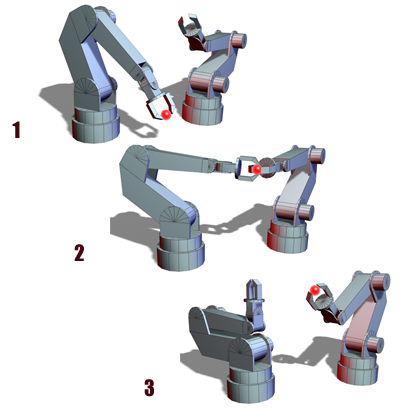You assign a Link constraint to an object to animate links from one parent to another. You use a link constraint instead of using the regular Select and Link and Unlink Selection buttons on the toolbar. (See Animation Constraints.)
An example of using a link constraint is to pass a ball from one hand to another. Assume that at frame 0 the ball is in the first hand. The hands are animated to meet at frame 50 and then spread apart until frame 100.
To animate the links for the ball:
- On the
 Motion panel, assign a Link constraint as the ball's Transform controller. You can also put a Link constraint on the ball from the Animation menu by choosing Constraints
Motion panel, assign a Link constraint as the ball's Transform controller. You can also put a Link constraint on the ball from the Animation menu by choosing Constraints  Link Constraint.
Link Constraint. -
 Go to frame 0, then on the Motion panel, click Add Link, and click the hand holding the ball. The ball will now move along with the hand, as if it were linked to it.
Go to frame 0, then on the Motion panel, click Add Link, and click the hand holding the ball. The ball will now move along with the hand, as if it were linked to it. - Drag the time slider to frame 50, where you want the second hand to pick up the ball, click Add Link, then click the second hand. From this frame on, it's as if the ball were linked to the second hand.
When you play back the animation, the ball travels with the first hand until frame 50, where you added the second link, then the ball is passed to the second hand for the rest of the animation.

Robot arms pass a ball from one hand to the other.
Adding and Deleting Links
You add and delete links on the Motion panel. Expand the Link Parameters rollout and click Add Link or Delete Link.
- Click Add Link then click the object that you want to link to as a parent. The frame at which you add the link is the frame at which control is passed. You can change the link frame with the Start Time parameter.
- Click the name of a parent object in the list, and then click Delete Link to remove the link.
Properties of the Link constraint include:
- The Link constraint respects the link inheritance settings applied to the child object.
- The object using a Link constraint is not a true child object. It does not appear in the subtree of any linked parent objects.
- Objects with Link constraint do not participate in IK solutions.
Link to World
You can also link an object to the world using the Link to World button. This will keep the object stationary without the use of a dummy object. Just click Link to World and the world is automatically entered as a Target.
Key Modes
You can choose between three different key modes, which determine how keyframes are written on the linked objects as part of the link constraint. These options provide the following:
- No Key Mode
-
No keys are created any of the objects involved. No keys will be visible in the track bar.
- Key Nodes
-
Sets keys for some of the objects. Child applies keys to the child object only. Parents applies keys to both parents and the child object.
- Key Entire Hierarchy
-
This applies keyframes to the chosen nodes and their entire hierarchies. Child keys the chosen object and the nodes in its hierarchy up to the world. Parents keys both parents and the child and all three hierarchies up to the world.
Side Effects of the Link Constraint
The Link constraint works to keep a child object from jumping position at the time when the link changes from one parent to another parent.
Considering the previous example, the following should hold true:
- During frames 0 to 50 the ball remains constant relative to the first hand.
- During frames 50 to 100 the ball remains constant relative to the second hand.
- At frame 50, the time when link control changes, the ball does not jump.
If you change the animation of the second hand at frame 75, it affects the position of the hand relative to the ball at the time of the link (frame 50). This change in relative position affects the ball over all frames where it is linked to the second hand. Therefore, as you change the position of the hand at frame 75, the child's position will also change, possibly in a counter-intuitive way. However, when playing back the animation the above three rules will hold true.